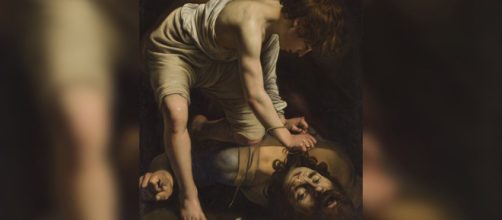If you're picking an artist to dramatize Goliath’s violent end, Caravaggio would be the logical choice, if only because of his uninterrupted record of criminal behavior, including murder.
His painting “David with the Head of Goliath” is in the news owing to an “extensive” restoration by the Prado Museum. But based on the photos provided by the museum, I question whether the cleaning benefits the painting. (I’ll get back to that).
It’s not only Caravaggio’s criminal record that gives him the creds to capture the ferocity of Goliath’s final moments when David lops off his head.
It’s his large number of similarly blistering scenes all made extra fierce for their strong darks and lights.
Consider “The Conversion of St. Paul.” Caravaggio describes Saul falling off his horse in a stable blinded by a great shaft of light in otherwise impenetrable darkness. I can’t talk enough about this painter’s revelatory use of light and shade.
You can see the power of his opposite tones in paintings like “Sacrifice of Isaac.” While Isaac’s mouth twists open screaming as his father holds him down, knife in hand, readying to slaughter him, it’s the heavy darks that punch up his son’s terror.
“Raising of Lazarus” also bears those same relational tones in its description of an inert Lazarus slumped against the arms of those behind him.
But it’s the jarring lighting that haunts me.
Missing in action
And that’s what’s missing in the restored “David with the Head of Goliath” – light and shade poles apart. By removing layers of varnish and dirt, the Prado also seems to have removed Caravaggio’s signature approach to painting.
There’s just too much diffuse light in the painting now. It has the washed-out look of an over-exposed photograph. Not only is all drama lost, but the painting also ends up telling a different story.
Cleaned up, David no longer looks as if he’s bending over Goliath to finish him off. Instead, the now brightly lit scene gives the impression of a good Samaritan stooping to help a fallen figure.
According to Almudena Sánchez, the restorer who led the project at the Prado, it “reveals a new Caravaggio, giving us a previously unknown image.”
That’s the problem.
The restoration leaves us with an “unknown image.” Now the luminosity leeches out the drama of David, sword in hand, readying to take Goliath’s head off. Where are those deep shadows to give color to this scene?
At the movies
I’m reminded of another restoration, a successful one in 2022 of the film “The Godfather,” with its play of dark and light intact.
Gordon Willis, the movie’s cinematographer, used deep shadows to express the dark side of the characters in the film. What he did is comparable to what Caravaggio did over and over – leave most of a scene unlit.
That’s all gone now. Instead, Prado’s restoration comes off as a pastoral scenery in the faded light of an old Doris Day movie.


